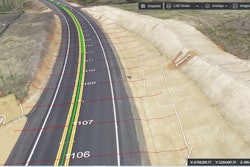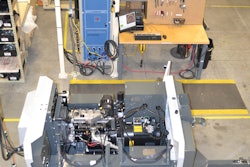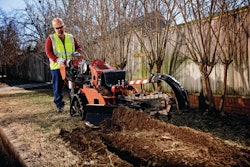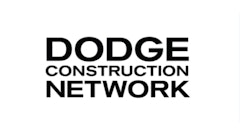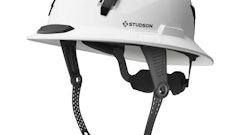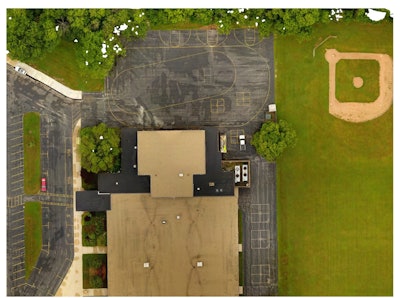
Unmanned aerial systems (UAS) or drones seem to be dominating many conversations in the construction industry. The paving and pavement maintenance industry has taken these drones from a marketing tool and turned them in to a real way to increase profits in their daily operations.
Ryan Anderson, owner of Premier Sealcoating in Oxford, MA, says the use of drones has revolutionized the way they do business and they continue to find new uses for them every day.
“We bought our drone for the same reason everyone else started using them,” Anderson says. “Our jobs were getting too big to take before and after shots with cell phone cameras for proof of completion and marketing purposes. But since we’ve started using them they’ve completely changed how we do business from start to finish.”
Initial Purchase
When Anderson sought to buy a drone, he did his research first.
“You can go out and buy a drone for a few hundred dollars, but is it going to do what you want it to do and will you be able to fly it without breaking it and losing your money,” he says. “We made sure to buy a drone that came with a tutorial on how to use it so we protected our investment that way.”
Anderson also made sure the drone he purchased had the technical aspects he was looking for in order to make sure he could get the data that he wanted out of each flight.
“YouTube is a wealth of information for drones,” he says. “You can do a simple search of what you’re wanting to accomplish with your drone and find the right fit for your application.”
Although purchase and operation of a drone may be easy, be sure to operate your drone legally. As of August 1 2016, all drones are required to be registered and fly in compliance with Federal Aviation Administration (FAA) regulations.
“All purchased drones today should come with a packet of information with instructions and a website to register your drone with the FAA to become compliant along with instructions for legal operation,” Anderson says. “The drone must be labeled with your registration number and information.”
Commercial businesses can apply for a waiver that allows you to fly your drone in more locations (as drones are not meant to be legally flown outside your field of vision) and at different altitudes than recreational users.
Visit www.faa.gov for more information.
Drone Project Monitoring
Once the drone was purchased, Anderson soon discovered that his drone wasn’t just good for taking pretty pictures, it could really help him increase job productivity.
“When you’re contacted to do a job, you’re given a blueprint of the job and expected to set your striping layout accordingly,” he says. “Now, we bring the drone out, take a picture of the lot when it’s done and superimpose the photo onto the blueprint to show the job was completed exactly as the plan called for.”
Once Anderson and his team discovered this step for proof and verification, they began to think of ideas to take the use of the drone further.
“We started to think of how we could use the drone from the beginning of a project and not just at the end,” he says. “That’s where job productivity really started to improve.”
Anderson purchased a Phantom 4 Drone (which retails for around $1,500) that came with an application which allows him to point to a spot on a map and have the drone fly to it, up to five miles away. This comes in especially handy during the bid process and project layout.
“The point from where the drone takes off to the designated spot where it flies is all measureable,” Anderson says. “Instead of walking with a wheel 780-ft. across the parking lot, you can send a drone out to the same spot on that map and just record the data. On some of the bigger parking lots, this can add up to huge time and energy savings for the crew.”
In addition, his sales team is able to use the drone to easily asses the condition of the entire lot and make an estimate based on those photos.
“Before we had the drone, my sales team was maybe able to estimate 1-2 parking lots a day,” Anderson says. “That’s with driving to the location, measuring the lot, counting 700-800 spots, estimating the linear cracks, etc.
“Now, one guy can complete an estimate about every two hours and I don’t have to send a second guy with him to do any measuring. He sends the drone up, gets the measurements and the photos and can count the stalls from his office to come up with his estimates from each stop at the end of the day.”
Anderson says this has also helped to improve things from a business perspective as his estimators can not only do more work, but they now have an archive and documentation of each parking lot the company has looked at.
“The sales team takes those photos and adds them to the estimate list,” Anderson says. “So in six months when a customer calls, he can easily still pull up the address and access the flyover and be able to accommodate the customer again in that way.”
A Better Prepared Crew
Those photos and videos that are taken before a project begins can also be helpful in prepping the crew.
“We go and map out a neighborhood that we were going to do crackfilling in, have a morning meeting to show the video and the crew has seen everything that needs to be done that day before they even leave the garage,” Anderson says. “They know the hazards, the challenges, everything. When they’re prepared, the job is done more efficiently and they can move on to other work faster.”
The crew finds the drone especially helpful on striping jobs where they can used the photos to compare it to the blueprint and start striping faster than ever.
“We take a picture of the lot once it’s laid out and send it to the engineer across town for verification,” Anderson says. “He can compare it to the blueprint and verify the plan before any paint goes down. That saves us a step and a lot of time to have the engineer to come out and inspect it before we can do the work.”
Andersons says the photos are especially helpful for project quality and holding everyone accountable for their work, freeing him up from being on every jobsite.
“If its new pavement, you only have one chance to lay it out and one chance to stripe it,” he says. “It’s not like you can black the paint out and do it over and a lot of times it’s the last thing to be done so everything is waiting on you. If it’s a high profile job, I would have been reluctant to not be on that jobsite, but now they can lay it out in chalk, send it to me on another job and I can give them approval for the work right away.”
Marketing Matters
In this industry, anything you can do to differentiate yourself from your competitors will help you gain an edge. Even if you only use your drone for photos and video marketing purposes, Anderson says it’s worth it.
“As a guy who is providing a service for dollars and a customer spends $50,000 on a parking lot, you want to be able to hand them a photo of their parking lot and say ‘this is where you’re money went,’” Anderson says. “A lot of times when you are doing large properties, shopping malls, ect they are owned by a Real Estate Investment Trust which may be a group of people or businesses that could be scattered all over the country. Not only is it good to show them where their money went, but it makes them think what their other properties could look like. We have seen a huge increase in these types of jobs for that fact alone. It’s an expensive tool but they are 100% worth it.”





